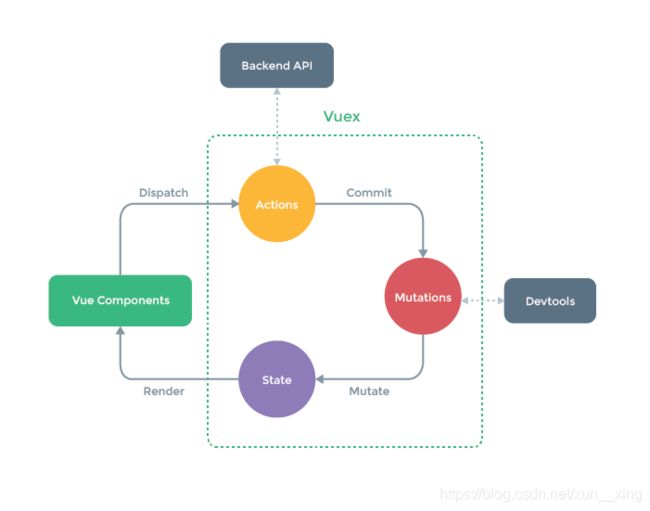Vue学习—深入剖析vuex
深入剖析vuex
- 一、State
-
- 1.安装
- 2.使用
- 3.State
-
- 1.在Vue组件中获得Vuex状态
- 2.mapState 辅助函数
- 二、Vuex_Getter
-
- 1.通过属性访问
- 2.通过方法访问
- 3.mapGetters 辅助函数
- 三、Vuex_Mutation
-
- 1.在组件中提交 Mutation
- 2.提交载荷(Payload)
- 3.对象风格的提交方式
- 4.使用常量替代 Mutation 事件类型
- 5.Mutation 需遵守 Vue 的响应规则
- 6.表单处理
-
- 1.双向绑定的计算属性
- 7.Mutation 必须是同步函数
- 8.严格模式
-
- 1.开发环境与发布环境
- 四、Vuex_Action
-
- 1.分发Action
- 2.组合 Action
- 3.Vuex 管理模式
- 五、Vuex_Module
-
- 1.命名空间
- 2.模块的局部状态
一、State
Vuex是vue的状态管理工具,为了更方便的实现多个组件共享状态。
1.安装
npm install vuex --save
2.使用
import Vue from 'vue';
import Vuex from 'vuex';
Vue.use(Vuex);
const store = new Vuex.Store({
state: {
count: 0
}
})
new Vue({
store,
})
3.State
单一状态树,使用一个对象就包含了全部的应用层级状态。
1.在Vue组件中获得Vuex状态
Vuex 通过store 选项,提供了一种机制将状态从跟组件“注入”到每一个子组件中(调用Vue.use(Vuex))。
通过在根实例中注册store选项,该store实例会注入到根组件下的所有子组件中,且子组件能通过this.$store访问。
<div class="home">
{
{ $store.state.count }}
div>
2.mapState 辅助函数
当一个组件需要获取多个状态时,将这些状态都声明为计算属性会有些重复和冗余。为了解决这个问题,我们可以使用mapState辅助函数帮助我们生成计算属性:
import {
mapState } from 'vuex';
computed: {
...mapState(['count']),
},
使用不同的名字:
computed: {
...mapState({
storeCount: state => state.count,
// 简写
storeCount: 'count', // 等同于 state => state.count
}),
},
二、Vuex_Getter
store的计算属性。getter的返回值会根据它的依赖被缓存起来,且只有当它的依赖值发生了改变才会被重新计算。
Getter 接收state作为其第一个参数、getters作为其第二个参数。
getters: {
doubleCount (state) {
return state.count * 2;
}
}
1.通过属性访问
Getter会暴露为store.getters对象:this.$store.getters.doubleCount
2.通过方法访问
也可以让getter返回一个函数,来实现给getter传参
getters: {
addCount: state => num => state.count + num;
}
this.$store.addCount(3);
3.mapGetters 辅助函数
import {
mapsGetters } from 'vuex';
export default {
computed: {
...mapGetters([
'doubleCount',
'addCount',
])
}
}
如果你想将一个 getter 属性另取一个名字,使用对象形式:
mapGetters({
// 把 `this.doneCount` 映射为 `this.$store.getters.doneTodosCount`
storeDoubleCount: 'doubleCount'
})
三、Vuex_Mutation
更改 Vuex 的 store 中的状态的唯一方法是提交 mutation。
const store = new Vuex.Store({
state: {
count: 1
},
mutations: {
increment (state) {
// 变更状态
state.count++
}
}
})
不能直接调用一个mutation handler。这个选项更像是事件注册:“当触发一个类型为increment的mutation时,调用次函数。”:
this.$store.commit('increment');
1.在组件中提交 Mutation
除了在组件中使用 this.$store.commit('xxx') 提交 mutation之外,还可以使用 mapMutations 辅助函数:
import {
mapMutations } from 'vuex'
export default {
// ...
methods: {
...mapMutations([
'increment', // 将 `this.increment()` 映射为 `this.$store.commit('increment')`
]),
...mapMutations({
add: 'increment' // 将 `this.add()` 映射为 `this.$store.commit('increment')`
})
}
}
2.提交载荷(Payload)
你可以向store.commit传入额外的参数,即mutation的载荷(payload):
mutations: {
increment (state, n) {
state.count += n
}
}
store.commit('increment', 10)
在大多数情况下,载荷应该是一个对象,这样可以包含多个字段并且记录的mutation会更易读:
mutations: {
increment (state, payload) {
state.count += payload.amount
}
}
store.commit('increment', {
amount: 10
})
3.对象风格的提交方式
提交 mutation 的另一种方式是直接使用包含 type 属性的对象:
store.commit({
type: 'increment',
amount: 10
})
当使用对象风格的提交方式,整个对象都作为载荷传给 mutation 函数,因此 handler 保持不变:
mutations: {
increment (state, payload) {
state.count += payload.amount
}
}
4.使用常量替代 Mutation 事件类型
把这些常量放在单独的文件中可以让你的代码合作者对整个 app 包含的 mutation 一目了然:
// mutation-types.js
export const COUNT_INCREMENT = 'COUNT_INCREMENT'
// store.js
import Vuex from 'vuex'
import {
COUNT_INCREMENT } from './mutation-types'
const store = new Vuex.Store({
state: {
... },
mutations: {
[COUNT_INCREMENT] (state) {
// ...
}
}
})
用不用常量取决于自己,在需要多人协作的大型项目中,这会很有帮助。
5.Mutation 需遵守 Vue 的响应规则
既然 Vuex 的 store 中的状态是响应式的,那么当我们变更状态时,监视状态的 Vue 组件也会自动更新。这也意味着 Vuex 中的 mutation 也需要与使用 Vue 一样遵守一些注意事项:
- 最好提前在你的 store 中初始化好所有所需属性。
- 当需要在对象上添加新属性时,你应该
- 使用 Vue.set(obj, ‘newProp’, 123), 或者
- 以新对象替换老对象。例如,利用对象展开运算符我们可以这样写:
state.obj = { ...state.obj, newProp: 123 }
6.表单处理
在Vuex的state上使用v-model时,由于会直接更改state的值,所以Vue会抛出错误。
如果想要使用双向数据的功能,就需要自己模拟一个v-model: :value=“msg” @input=“updateMsg”。
1.双向绑定的计算属性
上面的做法,比v-model本身繁琐很多,所以我们还可以使用计算属性的setter来实现双向绑定:
<input v-model="msg">
computed: {
msg: {
get () {
return this.$store.state.obj.msg;
},
set (value) {
this.$store.commit(UPDATE_MSG, {
value });
}
}
}
7.Mutation 必须是同步函数
要记住 mutation 必须是同步函数。why?
mutations: {
[COUNT_INCREMENT] (state) {
setTimeout(() => {
state.count ++;
}, 1000)
},
}
执行上端代码,我们会发现更改state的操作是在回调函数中执行的,这样会让我们的代码在devtools中变的不好调试:当 mutation 触发的时候,回调函数还没有被调用,devtools 不知道什么时候回调函数实际上被调用,任何在回调函数中进行的状态的改变都是不可追踪的。
8.严格模式
开启严格模式,仅需在创建 store 的时候传入 strict: true:
const store = new Vuex.Store({
// ...
strict: true
})
在严格模式下,无论何时发生了状态变更且不是由 mutation 函数引起的,将会抛出错误。这能保证所有的状态变更都能被调试工具跟踪到。
1.开发环境与发布环境
不要在发布环境下启用严格模式!严格模式会深度监测状态树来检测不合规的状态变更,要确保在发布环境下关闭严格模式,以避免性能损失。
const store = new Vuex.Store({
// ...
strict: process.env.NODE_ENV !== 'production'
})
四、Vuex_Action
Action 类似于 mutation,不同在于:
- Action 提交的是 mutation,而不是直接变更状态。
- Action 可以包含任意异步操作
Action 函数接受一个与 store 实例具有相同方法和属性的 context 对象,因此你可以调用 context.commit 提交一个 mutation,或者通过 context.state 和 context.getters 来获取 state 和 getters:
const store = new Vuex.Store({
state: {
count: 0
},
mutations: {
increment (state) {
state.count++
}
},
actions: {
increment (context) {
context.commit('increment')
}
}
})
1.分发Action
store.dispatch('increment')
虽然和mutation差不多,但是在action中,可以执行异步操作,但是mutation中不行!!!
actions: {
incrementAsync ({
commit }) {
setTimeout(() => {
commit('increment')
}, 1000)
}
}
2.组合 Action
Action 通常是异步的,那么如何知道 action 什么时候结束呢?
actions: {
actionA ({
commit }) {
return new Promise((resolve, reject) => {
setTimeout(() => {
commit('someMutation')
resolve()
}, 1000)
})
}
}
store.dispatch('actionA').then(() => {
// ...
})
3.Vuex 管理模式
五、Vuex_Module
由于使用单一状态树,应用的所有状态会集中到一个比较大的对象。当应用变得非常复杂时,store 对象就有可能变得相当臃肿。
为了解决以上问题,Vuex 允许我们将 store 分割成模块(module)。每个模块拥有自己的 state、mutation、action、getter。
modules: {
a,
b
}
- 获取 state:this.$store.state.moduleName.xxx
- 获取 getter:this.$store.getters.xxx
- 提交 mutation:this.$store.commit(‘xxx’);
- 分发 action:this.$store.dispatch(‘xxx’);
- 可以通过mapXXX的方式拿到getters、mutations、actions,但是不能拿到state,如果想通过这种方式获得state,需要加命名空间。
1.命名空间
可以通过添加 namespaced: true 的方式使其成为带命名空间的模块。
- 获取 state:this.$store.state.moduleName.xxx
- 获取 getter:this.$store.[‘moduleName/getters’].xxx
- 提交 mutation:this.$store.commit(‘moduleName/xxx’);
- 分发 action:this.$store.dispatch(‘moduleName/xxx’);
- 可以通过mapXXX的方式获取到state、getters、mutations、actions。
2.模块的局部状态
对于模块内部的 mutation 和 getter,接收的第一个参数是模块的局部状态对象。
同样,对于模块内部的 action,局部状态通过 context.state 暴露出来,根节点状态则为 context.rootState。
对于模块内部的 getter,根节点状态会作为第三个参数暴露出来。
